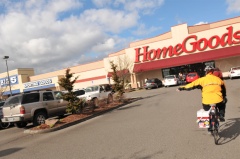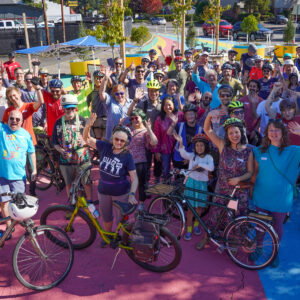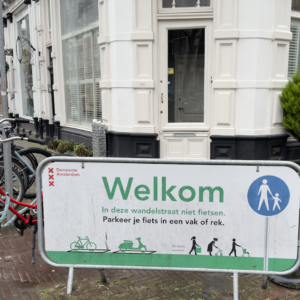
in suburbia can happen.
(Photo © J. Maus)
It’s a somewhat generally accepted concept in urban planning circles that there’s no hope for suburbia. Cinder block walls, cul-de-sacs, and wide arterials all make for a car-centric lifestyle. But new reseach shows that among suburban multifamily housing — the fastest growing housing type in the U.S. — biking and walking can thrive.
In Overlooked Density: Re-Thinking Transportation Options in Suburbia, Nico Larco, an assistant professor of architecture at the University of Oregon, focuses on suburban multifamily housing, which he calls a “widespread and overlooked example of density.”
“Dispelling commonly held beliefs about the amount of walking and biking occurring in suburbia, our study shows that more than a third of all trips to the LCA [local commercial area]… are active travel trips.”
His findings show that, not surprisingly, site design and connectivity to commercial areas are major factors in whether or not residents choose to walk or bike. Among developments in the study that were well-connected to commercial areas, more than 44% of residents choose to walk or bike to them — a rate that’s nearly twice as high as multifamily developments that lack connectivity.
But what is surprising is that, contrary to our popular perception of suburbia, “Across all studied developments, more than a third of all trips to nearby commercial strips are taken on foot, with a total of 38.7 percent taken on foot or by bicycle.”

Larco writes that there may be, “additional latent active transport in suburbia,” but it will only be realized if developers and planners make connectivity and “pass through” between their units and commercial areas a top priority. For those that get it right, here’s what they have to look forward to (taken from chapter 2 of the study):
“The latent potential in proximity of residences and commercial areas can reduce residents’ reliance on automobiles and increase active modes of travel such as walking and biking, especially for short trips under a half mile. Increasing active travel might reduce vehicle miles traveled, which has positive impacts on the environment as it reduces carbon emissions. In addition, walking and biking can have a positive effect on residents’ physical and mental health and can provide economic savings.”
Especially significant in Larco’s field of study are the health, economics, and equity implications. As he notes in the study, the typical demographic of suburban multifamily housing includes the elderly and lower-income individuals. “Increasing active travel for these populations,” Larco writes, “can have an economic effect as residents do not need to have access to automobiles or pay for additional fuel for these short trips.”
Larco’s study was funded by the Oregon Transportation Research and Education Consortium (OTREC). Learn more and download the final report at the OTREC website.






Thanks for reading.
BikePortland has served this community with independent community journalism since 2005. We rely on subscriptions from readers like you to survive. Your financial support is vital in keeping this valuable resource alive and well.
Please subscribe today to strengthen and expand our work.
Sheesh. Finally. Kudos to Larco for bringing this well-kept secret to light. The caption under your photo says it all, Jonathan: “As long as connections exist…”
As a suburban bike commuter who lives AND works in Beaverton, I see so many examples of, as Maxwell Smart might say, “missed it by that much!” bike lanes only on a few high-speed arterials like Murray Blvd. Routes through neighborhoods that take you a mile out of your way just following the winding maze of Avenues, Lanes, Courts, Terraces, Circles, Loops–how many names for “Street” are there? Then there are the lovely paved Mixed-use paths that are three feet wide and just end when they get to a “wetland”, only to continue on the other side, but not before you have to ride far out of the way along labyrinthine neighborhood streets and bike-lane-free arterials to pick them up again. Other “trails” are interrupted by ridiculous mid-block crossings that force either a dash across a 40 mph, 5-lane road, or a quarter-mile detour to the nearest pedestrian signal (when the mid-block is fenced off for “safety”). Many paths also cross quiet neighborhood streets mid-block, but have no curb cuts, making it just that much more inconvenient.
If suburban planners could have this collective epiphany and put non-motorized connecting paths between cul-de-sacs, complete connections along existing trails (and widen those trails), there could potentially be a huge boom in suburban cycling. After all, who needs to cut their gasoline expenses the most?
Now if we could only get suburban businesses to understand how parking a bike is actually done. “Wheel-breakers” haven’t cut it since 1978. A “wavy” rack 8″ from the wall of a building is practically useless. If you surround your bike rack with the latest seasonal plant display and make it difficult to find, let alone get to…etc.
Thanks again for publishing this story, Jonathan. There is huge potential in the suburbs; connectivity for “active” transport can be had for relative pennies (when compared to projects like widening Bethany Blvd, widening Hwy 26, etc.). If only those with control of the funds could see the possibilities…
Well said el Bici.
What you said. Beaverton just needs a tiny bit of work to be so much more bike friendly.
El Biciclero’s mention of various types of route diversions associated with suburban neighborhoods out in Beaverton is accurate. That’s all a product of market/developer driven planning based on archaic notions that motor vehicles…and only motor vehicles…would be the peoples transportation mode of choice into perpetuity.
Residents and property owners naively and gullibly went along with that way of thinking, creating many square miles of residential development of that type that’s now very hard to retro-fix.
It’s interesting to discover within your own neighborhood, just what necessities are accessible by a 10 minute walk or a 10 minute bike ride…a 20 minute walk, or a 20 minute bike ride. And what those trips are like. Check them out for yourself, and it becomes very easy to understand why people are instead using motor vehicles for such trips.
Oh, but hey…El Biciclero…easy on criticizing the various wetlands out here on the west side, even if they are micro-wetlands. I worry about discouraging people from doing what can done to keep all remaining wetlands and natural water features from being developed over; such as the creek on land a Downtown Beaverton property owner (that Burgerville leases from) wanted to pave over to create more parking area.
Oh, I’m not criticizing wetlands, per se–I love natural, undisturbed areas–but if some of the existing trails would have been built to skirt them, or if we could just build a few strategically located boardwalks to span them…
I know you weren’t, but I’m afraid people not well aware of how important these little spots of nature are, will interpret such remarks the wrong way, easily coming to the conclusion that such places are just obstructions to progress that should be blotted off the face of the earth.
Better, visionary planning could protect the integrity of natural areas while improving the appeal of and opportunities for satisfying trips on foot or bike. Boardwalks for MUP’s can work, though for natural areas to be used as commuter routes doesn’t make much sense to me. Commuter routes on their perimeter could be ok.
If only we could apply today’s standards and design philosophies to suburbs that were developed 20-40 years ago.
I was a kid in Beaverton during that time period. My perception and memory is that it was a lot safer to walk and ride your bike back then. I walked to school on Murray blvd. with no shoulder and it seems like the speed limit was 35 mph. Now it is 5 lanes at 45 + 5 mph and packed with rushing traffic.
Riding to Kmart (Murray/TV) for a sub sandwich and a cherry Icee was totally safe for a 12 year old.
In 1973 my classmates at Meadow Park held a fund raising drive to help raise $30,000 for a stop light at Murray and Butner. I’m not sure of the back story. But, it gives you an idea of how different things were back then. We did the same type of event for the path that is on Cornell between Sunset High and Miller Rd (3 miles?). You can still the remains of that path in places.
Believing in this “popular perception of suburbia” kinda makes one seem like one fits the “popular perception” of the urban elitist.
Nailed it!
It seems like this all breaks down to terminology. People often talk in terms of Urban/Suburban/Rural which are all just simplified ways to talk about the metric which actually matters: density.
If a majority of houses in a suburb are within walking distance of most necessities, is it really suburban?
I disagree that it is only about density. It is possible to have density without good connections and we can find examples of dense low income developments where because of lack of connections residents must use a car or bus to get to a grocery story 1/2 mile away. There are also areas of relatively low density that are connected. The connectivity of areas of high population density is more a reflection of the time when those street grids were laid out while the lack of connectivity of exurb developments reflects the lack or pre-existing grid and road networks.
I’ve found that much of suburban Long Island, Nassau County NY is actually very well connected with exceptions centered on parkways and expressways that chop up the communities. Even though the overall density is pretty low with suburban single family homes and very few apartments. Some of the developments are built in the classic 1960 loops that make straight routes impossible, but they remain connected to a relatively dense grid of through roads that predate the automobile centric development.
Jack raises a good question, but I think the answer is that while the impact of suburbs can be lessened by adding more local resources, such as a “village center” if you like, these are still suburbs if a large portion of the population has to travel outside of them on a daily basis to derive their principal income. Would certainly be nice if planners/developers included alternative modes of transportation as a matter of course, without simply assuming everyone’s going to drive and then making it a self-fulfilling prophecy. Of course the people that move into those locations tend to be a self-selecting bunch too, folks to whom bicycle options are less of a priority than to most of us visiting this website.
“…but I think the answer is that while the impact of suburbs can be lessened by adding more local resources, such as a “village center” if you like, these are still suburbs if a large portion of the population has to travel outside of them on a daily basis to derive their principal income. …” PorterStout
So you’re agreeing that suburbs are suburbs rather than urban areas, even though they may have services available within walking distance from within residences inside them. I’d tend to think, as you suggested, that the values of many if not most of the people choosing to reside within a suburb do not include being able to easily, safely, and pleasantly ride or walk to the store.
I’ve got a feeling though, that this is a conditioned value. It seems logical that big, wide, beautiful pedestrian-bike boulevards would cost somebody…property owners, developers…extra money. So they don’t get built. And also, people fall in love with their motor vehicles. That’s easy to do in Oregon winters when it’s 40 degrees out and raining. ‘Anybody up for a 15 minute walk to the store in the cold, dark of night in the rain?’.
I also believe, that if conditions favor it, all kinds of people of a range of physical condition, like to walk and bike from their house to somewhere. If facilities for that were built, people would use it at least some of the time.
People aren’t going to use what’s not built. Build a beautiful, pedestrian-bike avenue from within a neighborhood, out to where the services are, and I think more people living in the neighborhood would be interested in walking and biking from their homes to those services. At least some of the time they would, and anything in that direction would probably be a gain.
Jack:
That’s a good observation. Larco calls the report “Overlooked Density” for that reason. He’s looking at multifamily areas that are built between strip malls and single-family housing (the stereotypical suburbia). Many people do overlook the fact that a lot of people live in a very small area because of their perceptions of suburbia. His point is that better design can really tap into this density as a resource.
Beaverton Bicycle Advisory Committee. Be there.
The Getting to Work in Washington County panel in Hillsboro Wed evening. Be there.
http://www.facebook.com/event.php?eid=167593773293693
Represent. Speak UP.
I’m in East Portland… it’s the arterial streets – they cut us off like rivers with few bridges and safe crossings. The roar of 40-45 mph traffic between 122nd-108th on SE Stark for example… cuts off several churches, a store, a medical clinic, several apartment buildings, a park, the middle school and East Portland COMMUNITY Center. Oh we do OK – dashing across 5 lanes with strollers, praying drivers obey the ridiculously over marked yet INVISIBLE cross walk… the only crosswalk… A middle schooler gets hit every few years in the crosswalk and the CoP puts out a school zone for awhile – but last time they took it down from 7 a.m. to 5 p.m. because “compliance was low.” Nice. Now it lasts from 7 a.m. – 7:15 a.m. and again for 15 minutes in the afternoon.
I dunno it’s the little things… connectivity, sure… how about liveability too – oh I guess it’s all part of the puzzle.
That is one of the main reasons that I’ve found heavily suburban Nassau County, Long Island NY more connected and overall better riding that the greater Portland Vancouver area. The major arterials are roads that were laid out 250 years ago that go through historic village centers. Even though these are now modern, suburban arterials with 4 to 6 lanes of 50 MPH traffic, the village cores have short blocks and lots of stop lights making crossing these barriers much easier than streets like 122nd here.
Good article. Traffic jams are increasing on 205 morning and night…Traffic “congestion” jams are a major cause of Portland’s polluted air. We need a car diet strategy just as much as bike boulevards. Cyclists need clean air to thrive…